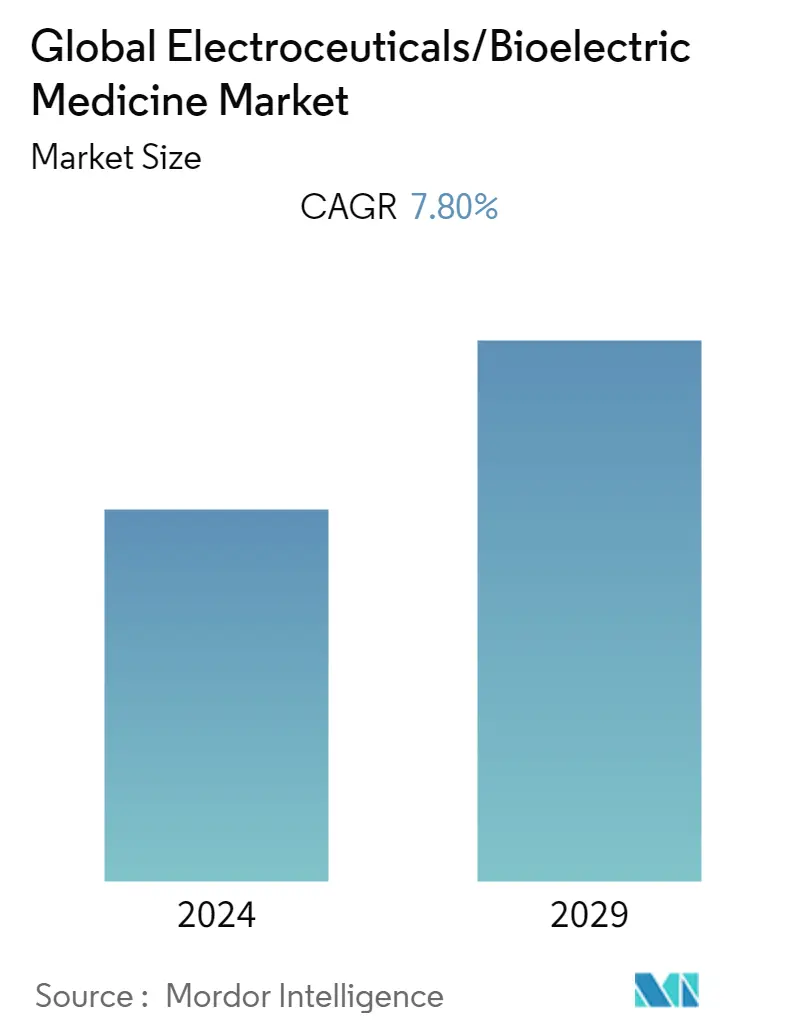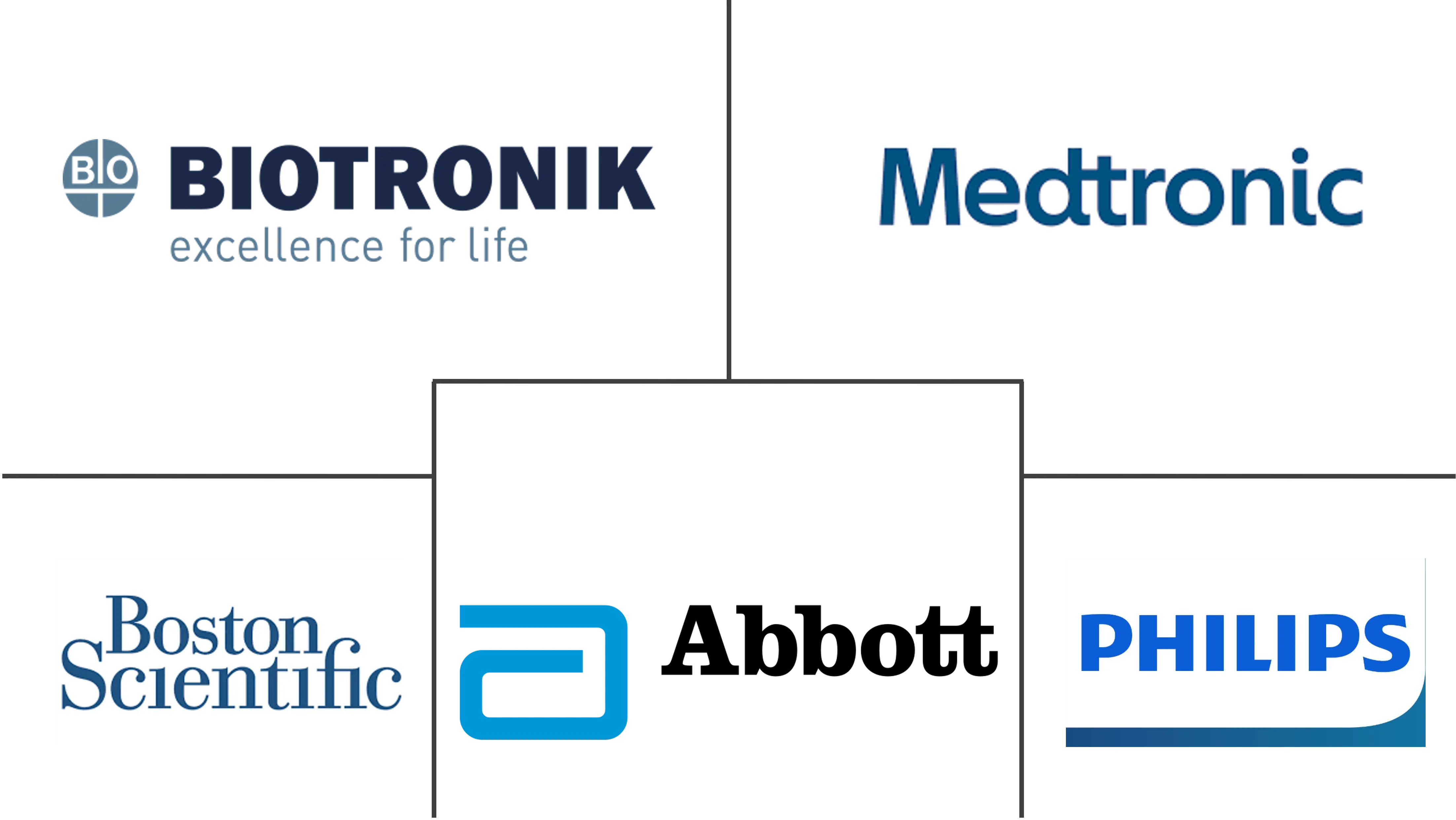Market Size of Global Electroceuticals/Bioelectric Medicine Industry

| Study Period | 2019 - 2029 |
| Base Year For Estimation | 2023 |
| CAGR | 7.80 % |
| Fastest Growing Market | Asia-Pacific |
| Largest Market | North America |
| Market Concentration | Medium |
Major Players
*Disclaimer: Major Players sorted in no particular order |
Electroceuticals/Bioelectric Medicine Market Analysis
The electroceuticals/bioelectric medicine market is projected to register a CAGR of 7.8% during the forecast period (2022-2027).
The COVID-19 epidemic has had a significant impact on the market. Due to the high rate of infection and the lack of treatment, many countries were suffering and continue to burden their economies and health care systems. Elective procedures have been postponed indefinitely during the COVID-19 pandemic to provide capacity to deal with the emergency caseload and avoid exposing elective patients to COVID-19. Also, as per the article published in August 2021 titled "Impact of COVID-19 pandemic on cardiac electronic device implantations in Northwestern Greece", The coronavirus disease (COVID-19) pandemic seems to have a significant impact on cardiovascular-related hospital visits and admissions. During the first lockdown period, both de novo implantations and replacements decreased significantly, while there was no significant change during the second lockdown period.
Globally, the rising prevalence of chronic disorders is a major factor driving the market forward. For instance, as per the April 2021 report of the World Health Organization (WHO), non-communicable diseases (NCDs), also known as chronic diseases, are long-duration diseases and are the result of a combination of genetic, physiological, environmental, and behavioral factor. According to the article titled ' Prevalence of Non-Communicable Diseases Among Indiands is 116 per 1,000 : Report' published in July 2021 Prevalence of non-communicable diseases in India is 11 per 1,000 population with hypertension, digestive diseases and diabetes leading the burden. Additionally, an increase in the geriatric population at risk of neurological and CVD diseases is expected to fuel market growth over the forecast period.
Bioelectronic Medicine promises to bring new insights into diagnosing and treating diseases and conditions as varied as cancer, rheumatoid arthritis, inflammatory bowel disease, obesity, diabetes, asthma, paralysis, blindness, bleeding, ischemia, and organ transplantation, cardiovascular disease, neurodegenerative diseases, and others. Building on a surge of progress in the past decade, the field is rapidly expanding. Technical innovations are making devices smaller and less invasive, with companies bringing new applications to market in the next several years, including for peripheral neuropathy, arthritis, chronic obstructive pulmonary disease, heart failure, and Type 1 diabetes.
Bioelectric Medicine is being developed by market participants as well. For example, GE Research's bioelectronic medicine team is using ultrasound to demonstrate potentially groundbreaking non-invasive methods to regulate dysfunction in the body's metabolic or inflammatory control systems. Bioelectronic medicine research traditionally relied on implanted devices to stimulate nerves and achieve therapeutic results. The GE Research team demonstrates the precise stimulation of nerve features directly within target organs using a non-invasive ultrasound technique. The preliminary findings of the GE Research team indicate that more investment and research into the use of ultrasound for peripheral neuromodulation is warranted and that increased collaboration between ultrasound device engineers and neuroscientists will be required. Hence, showing potential and simultaneously the need for investment in the biomedicine market.
Researchers are now looking into developing various bioelectronics-based therapeutic devices for tumor stimulation and neural modulation. This allows for the control of cancer signaling pathways, the restoration of healthy electrical impulse patterns, and the prevention of cancer progression. Recent advancements in bioelectric Medicine may prove to be a more natural and safe approach to cancer treatment than chemotherapy and surgery, both of which have numerous side effects. In today's world, patients with certain types of cancer are given electric field therapies in addition to chemotherapy to improve survival and safety. For instance, Bryne et al. showed that a high concentration of localized drugs could be forced deep inside the tumors using low direct current electric fields, referred to as "iontophoretic chemotherapy".
Also," per the article published in December 2020, "Core Concept: The rise of bioelectric medicine sparks interest among researchers, patients, and industry," the ph,"maceutical industry is also on board. Johnson & Johnson's portfolio now includes several bioelectronic devices. This is likely to boost the market growth over the forecast period.
Thus the above mentioned factors are expected to drive the growth of the market during the forecast period.
Electroceuticals/Bioelectric Medicine Industry Segmentation
As per the scope of this report, bioelectronic medicine focuses on electrical signaling in the nervous system. Bioelectronic medicine is a new approach to treating and diagnosing disease. It represents a convergence of molecular medicine, neuroscience, and bioengineering. It uses a medical device (electrical pulses) and the body's natural mechanisms as an adjunct or alternative to drugs and medical procedures. The Electroceuticals/Bioelectric Medicine Market is Segmented by Device Type (Implantable Electroceutical Devices, Non-invasive Electroceutical Devices), by Product Type (Defibrillators, Pacemakers, Stimulator, and Others), by Application (Arrhythmia, Pain Management, Parkinson's Disease, Depression, Others), End-user (Hospitals, Clinics, Others) and Geography (North America, Europe, Asia-Pacific, Middle East, and Africa, and South America). The report also covers the estimated market sizes and trends for 17 countries across major regions globally. The report offers the value (USD million) for the above segments.
| By Device Type | |
| Implantable Electroceutical Devices | |
| Non-invasive Electroceutical Devices |
| By Product | |
| Defibrillators | |
| Pacemakers | |
| Stimulators | |
| Others |
| By Application | |
| Arrhythmia | |
| Pain Management | |
| Parkinson's Disease | |
| Depression | |
| Others |
| End User | |
| Hospitals | |
| Clinics | |
| Others |
| Geography | ||||||||
| ||||||||
| ||||||||
| ||||||||
| ||||||||
|
Global Electroceuticals/Bioelectric Medicine Market Size Summary
The electroceuticals and bioelectric medicine market is experiencing significant growth, driven by the increasing prevalence of chronic disorders and the rising geriatric population at risk of neurological and cardiovascular diseases. This market is characterized by its focus on using electrical impulses to diagnose and treat various conditions, including cancer, diabetes, and cardiovascular diseases. The field is rapidly expanding due to technological innovations that make devices smaller and less invasive, offering new applications for conditions such as peripheral neuropathy and heart failure. The COVID-19 pandemic has impacted the market by delaying elective procedures, but it has also highlighted the importance of advanced healthcare solutions, thereby potentially accelerating market growth. The presence of established players like Medtronic and Biotronik, along with favorable government support and regional product approvals, further bolsters the market's expansion.
The market is competitive and fragmented, with several major players actively developing and marketing bioelectronic devices. Companies are investing in research and development to create non-invasive therapeutic devices that can modulate neural pathways and improve treatment outcomes for chronic diseases. Recent advancements suggest that bioelectric medicine could offer safer alternatives to traditional treatments like chemotherapy. The market's growth is also supported by the increasing acceptance of products such as defibrillators and pacemakers, alongside technological advancements in these devices. Partnerships and collaborations, such as those between Merck KGaA and Innervia Bioelectronics, are expected to drive innovation and address unmet medical needs, further propelling the market forward.
Global Electroceuticals/Bioelectric Medicine Market Size - Table of Contents
-
1. MARKET DYNAMICS
-
1.1 Market Overview
-
1.2 Market Drivers
-
1.2.1 Rising Geriatric Population and Subsequent Growth in the Prevalence of Neurological & Cardiovascular Disorders
-
1.2.2 Technological Advancements
-
-
1.3 Market Restraints
-
1.3.1 High Cost of Electroceutical Devices
-
-
1.4 Porter's Five Forces Analysis
-
1.4.1 Threat of New Entrants
-
1.4.2 Bargaining Power of Buyers/Consumers
-
1.4.3 Bargaining Power of Suppliers
-
1.4.4 Threat of Substitute Products
-
1.4.5 Intensity of Competitive Rivalry
-
-
-
2. MARKET SEGMENTATION (Market Size by Value - USD million)
-
2.1 By Device Type
-
2.1.1 Implantable Electroceutical Devices
-
2.1.2 Non-invasive Electroceutical Devices
-
-
2.2 By Product
-
2.2.1 Defibrillators
-
2.2.2 Pacemakers
-
2.2.3 Stimulators
-
2.2.4 Others
-
-
2.3 By Application
-
2.3.1 Arrhythmia
-
2.3.2 Pain Management
-
2.3.3 Parkinson's Disease
-
2.3.4 Depression
-
2.3.5 Others
-
-
2.4 End User
-
2.4.1 Hospitals
-
2.4.2 Clinics
-
2.4.3 Others
-
-
2.5 Geography
-
2.5.1 North America
-
2.5.1.1 United States
-
2.5.1.2 Canada
-
2.5.1.3 Mexico
-
-
2.5.2 Europe
-
2.5.2.1 Germany
-
2.5.2.2 United Kingdom
-
2.5.2.3 France
-
2.5.2.4 Italy
-
2.5.2.5 Spain
-
2.5.2.6 Rest of Europe
-
-
2.5.3 Asia-Pacific
-
2.5.3.1 China
-
2.5.3.2 Japan
-
2.5.3.3 India
-
2.5.3.4 Australia
-
2.5.3.5 South Korea
-
2.5.3.6 Rest of Asia-Pacific
-
-
2.5.4 Middle-East and Africa
-
2.5.4.1 GCC
-
2.5.4.2 South Africa
-
2.5.4.3 Rest of Middle-East and Africa
-
-
2.5.5 South America
-
2.5.5.1 Brazil
-
2.5.5.2 Argentina
-
2.5.5.3 Rest of South America
-
-
-
Global Electroceuticals/Bioelectric Medicine Market Size FAQs
What is the current Global Electroceuticals/Bioelectric Medicine Market size?
The Global Electroceuticals/Bioelectric Medicine Market is projected to register a CAGR of 7.80% during the forecast period (2024-2029)
Who are the key players in Global Electroceuticals/Bioelectric Medicine Market?
Boston Scientific Corporation, Medtronic , Biotronik SE & Co. KG , Koninklijke Philips N.V. and Abbott Laboratories are the major companies operating in the Global Electroceuticals/Bioelectric Medicine Market.

